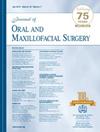Association of Preoperative Nutritional Status With Outcomes in Fronto-Orbital Advancement for Syndromic Craniosynostosis
IF 2.6
3区 医学
Q2 DENTISTRY, ORAL SURGERY & MEDICINE
引用次数: 0
Abstract
Background
Calvarial vault remodeling (CVR) is a critical procedure for patients with syndromic craniosynostosis (SC), a condition associated with genetic syndromes and comorbidities that can worsen nutritional status before surgery. Despite nutritional challenges in this population, few studies have assessed how preoperative nutritional health correlates with complications, relapse, or hospital stay after CVR.
Purpose
The study purpose was to measure the association of nutritional status on surgical outcomes in patients with SC undergoing CVR.
Study Design, Setting, Sample
This study was a retrospective cohort analysis of pediatric subjects with SC who underwent CVR between 2002 and 2024 at a children's hospital in Los Angeles. Patients surgically treated at external hospitals were excluded.
Predictor Variable
The primary predictor variable was nutritional status, measured using weight-for-length (WFL) percentile, with higher values indicating better nutritional status. Gastrostomy tube (G-tube) dependency and preoperative serum albumin were included as secondary predictors.
Main Outcome Variable(s)
The primary outcome was the occurrence of postoperative complications, including hematomas, unplanned reoperation, and skeletal relapse. Secondary outcomes included length of stay, readmissions, and mortality.
Covariates
The covariates were demographics (age, sex, and prematurity) and surgical parameters (anesthesia time and blood transfusions).
Analyses
Statistical analyses included χ2 tests, analysis of variance, t-tests, and regression analyses to assess the relationships between nutritional status and outcome variables. A P value of < 0.05 was considered statistically significant.
Results
The study included 86 patients (mean age 12.4 ± 10.9 months); 14% (n = 12) were premature and 21% (n = 18) were G-tube dependent. G-tube dependent patients had significantly lower WFL percentiles compared to those without G-tubes (26.4 vs 43.5, P < .001). Lower WFL scores were significantly associated with higher rates of postoperative complications (P = .047). Regression analysis showed that for every 10-point increase in WFL percentile, the predicted probability of complications decreased by 6.5% (P < .001).
Conclusions and Relevance
Low WFL and G-tube dependency were statistically significantly associated with a higher rate of postoperative complications in patients with SC undergoing CVR. These findings suggest that careful assessment and optimization of preoperative nutritional status may help reduce the risk of complications and improve patient outcomes.
术前营养状况与综合征性颅缝闭锁额眶前移预后的关系。
背景:颅穹窿重塑(CVR)是综合征性颅缝闭塞(SC)患者的关键手术,SC是一种与遗传综合征和合并症相关的疾病,可使术前营养状况恶化。尽管这一人群存在营养方面的挑战,但很少有研究评估术前营养健康与CVR术后并发症、复发或住院时间的关系。目的:研究目的是衡量营养状况与行CVR的SC患者手术结果的关系。研究设计、环境、样本:本研究对2002年至2024年在洛杉矶一家儿童医院接受CVR的SC患儿进行回顾性队列分析。排除在外部医院接受手术治疗的患者。预测变量:主要预测变量是营养状况,使用体重长度(WFL)百分位数测量,数值越高表明营养状况越好。胃造口管(g管)依赖性和术前血清白蛋白作为次要预测因素。主要结局变量:主要结局是术后并发症的发生,包括血肿、计划外再手术和骨骼复发。次要结局包括住院时间、再入院率和死亡率。协变量:人口统计学(年龄、性别和早产)和手术参数(麻醉时间和输血量)。分析:统计分析包括χ2检验、方差分析、t检验和回归分析,以评估营养状况与结果变量之间的关系。P值< 0.05认为有统计学意义。结果:纳入86例患者,平均年龄12.4±10.9个月;14% (n = 12)早产,21% (n = 18)依赖g管。g管依赖患者的WFL百分位数明显低于无g管患者(26.4 vs 43.5, P < 0.001)。WFL评分越低,术后并发症发生率越高(P = 0.047)。回归分析显示,WFL百分位数每增加10个点,并发症的预测概率降低6.5% (P < 0.001)。结论及相关性:低WFL和g管依赖与SC行CVR患者术后并发症发生率较高有统计学意义。这些发现表明,仔细评估和优化术前营养状况可能有助于降低并发症的风险并改善患者的预后。
本文章由计算机程序翻译,如有差异,请以英文原文为准。
求助全文
约1分钟内获得全文
求助全文
来源期刊

Journal of Oral and Maxillofacial Surgery
医学-牙科与口腔外科
CiteScore
4.00
自引率
5.30%
发文量
0
审稿时长
41 days
期刊介绍:
This monthly journal offers comprehensive coverage of new techniques, important developments and innovative ideas in oral and maxillofacial surgery. Practice-applicable articles help develop the methods used to handle dentoalveolar surgery, facial injuries and deformities, TMJ disorders, oral cancer, jaw reconstruction, anesthesia and analgesia. The journal also includes specifics on new instruments and diagnostic equipment and modern therapeutic drugs and devices. Journal of Oral and Maxillofacial Surgery is recommended for first or priority subscription by the Dental Section of the Medical Library Association.
 求助内容:
求助内容: 应助结果提醒方式:
应助结果提醒方式:


